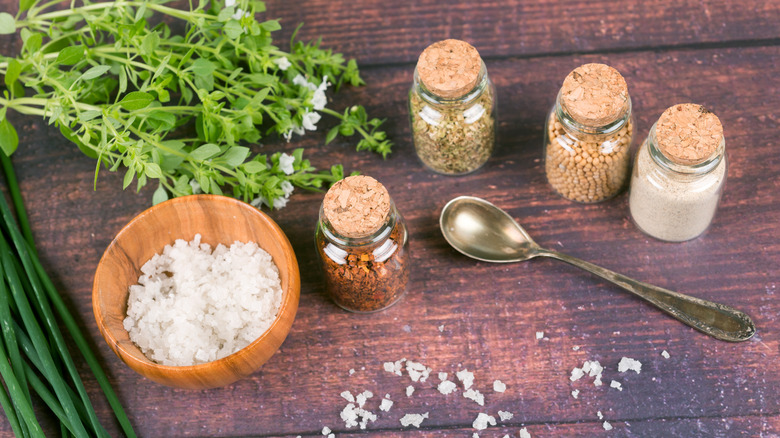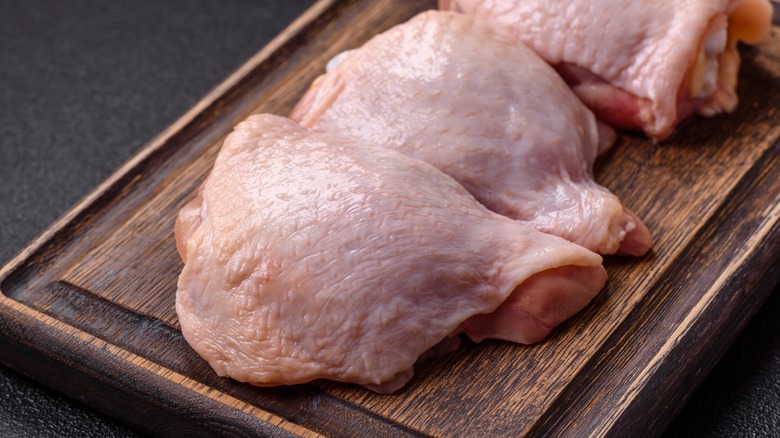Cook Tender, Well-Seasoned Chicken Thighs In One Simple Step
Chicken thighs are some of the most versatile meat around, as good in cider-braised chicken with cabbage and thyme as they are served up with sweet and savory flavors after a marinade in a maple ginger mix. While some eschew dark meat, thighs are the preferred cut for many who appreciate how forgiving they are when cooking on high heat, and how flavorful they are on their own. But according to executive chef Samuel-Drake Jones of Hudson VU in NYC, if you want the ultimate in tender, well-seasoned chicken thighs, there is one prep step you should never forget. "Brining — especially wet brining — hydrates the meat and seasons it more deeply than surface seasoning can," the expert told Food Republic in an exclusive interview.
"Chicken thighs, with their higher fat content and connective tissue, retain moisture well," the expert continued, explaining that a brine ensures the interior muscle fibers absorb water and salt, which aids in breaking down some of the chicken's proteins. The end result is juicier, tastier meat throughout, not just on the surface where you apply your seasonings. While most chicken recipes technically only has to be cooked to 165 degrees Fahrenheit to be considered safe for consumption, a brine "... helps the thighs stay tender even when cooked to a higher internal temperature, which is ideal for thighs — around [175 to 185 degrees Fahrenheit]," according to our expert.
How to wet brine your chicken thighs
Samuel-Drake Jones had a suggestion for how to get the salt and timing ratio correct when wet brining your chicken thighs: "Use a 5 [percent] salt-to-weight ratio, and let the meat sit in the brine...for about six to 12 hours." You can, of course, use just salt in the brine, but if you'd like to play around with imbuing other flavors into your meat, you can add additional seasonings like whole peppercorns, garlic cloves, bay leaves, or even brown sugar for a kiss of sweetness. Regardless of what you add, make sure the pieces of chicken are all completely submerged in the liquid.
Once you've pulled the chicken out of the brine, you'll want to simply pat the pieces down with paper towels, and avoid turning on the faucet. Rinsing will produce the same effect as washing your chicken: splattering and spreading potentially bacteria-laden juices around your sink and kitchen surfaces, ultimately doing more harm than good. No, instead you'll just pat your chicken thighs dry, then season them. You should also refrain from adding any additional salt during this step, since they've been sitting in what is essentially a salt bath for hours.
What about dry brining chicken?
If you've heard of wet brining, you might also have heard of dry brining, though according to Samuel-Drake Jones, "[dry] brining is not a real thing, rather a term popularized by online bloggers and content creators." The technique known as dry brining is actually called "curing," the expert explained. This method effectively pulls out moisture from the chicken skin to the surface of the protein, then breaks down the salt and imbues it back into the meat, which seasons and flavors it. For this reason, curing is typically best for skin-on chicken thighs.
Jones told Food Republic he prefers a wet brine, but does acknowledge that it's messier than curing. He recommended the same amount of salt and time as he did for the wet brine: a 5 percent ratio of salt to water, and let the chicken sit in the fridge, uncovered, for as few as six, and as many as 12 hours. Jones addended his instructions for curing, however — if you are going to use the cure method for your chicken, you shouldn't let it sit for longer than 12 hours, and you should "dry the protein so it can get a nice sear!"



